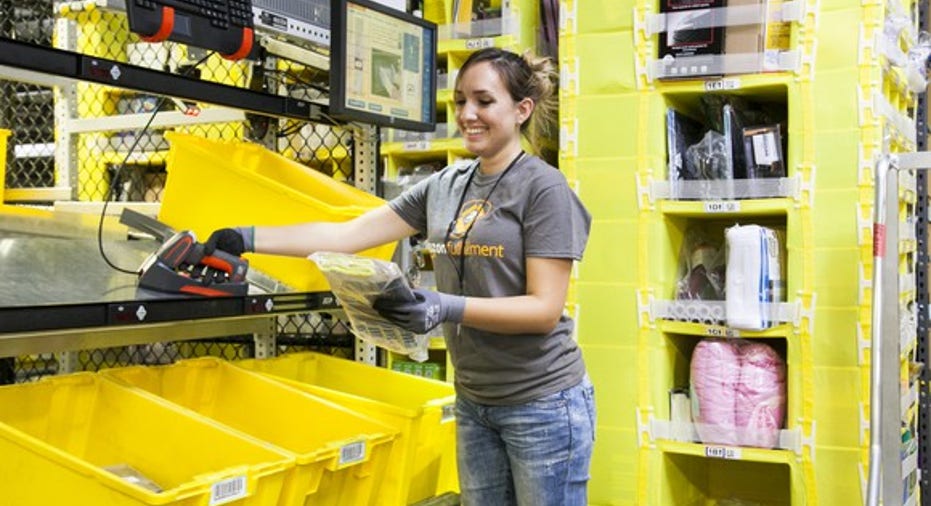Amazon.com Is Giving Us a Closer Glimpse of Its Prime Subscriber Numbers

Amazon.com (NASDAQ: AMZN) doesn't like to give Wall Street more information than it has to. It took a long time for the company to show investors the financials of Amazon Web Services, its cloud computing platform, and it was already a $4.6 billion business by the time Amazon did. But Amazon's reporting a new revenue category for its retail operations that gives us a small glimpse into how big Amazon Prime is.
In its latest 10-K filing, Amazon reported a line item called "retail subscription services." The segment includes "annual and monthly fees associated with Amazon Prime membership, as well as audiobook, e-book, digital video, digital music, and other subscription services," according to the SEC filing. Those services brought in $6.4 billion in revenue last year.
The number could give us a hint as to how many Prime members Amazon has.
Image source: Amazon.com.
The minimum number of Prime members
Over the past few years, management has given us some hints as to how many Prime members Amazon has. Here's what management said, and what it implies for Amazon's membership numbers.
How do those numbers compare with subscription revenue?
What's interesting about these implied numbers is that subscription revenue grew at the same rate as Prime members last year -- 43%. Subscription revenue grew 62% in 2015, faster than the 51% growth in Prime membership. So while Prime is definitely the biggest factor, it's not the only thing contributing revenue.
Audible, with its "millions of subscribers" paying at least $14.95 per month, is a sizable factor as well, at least 5%. Add in a few Kindle Unlimited subscribers and some Amazon Music subscribers, and it's possible Prime accounts for as much as 90% of Amazon's subscription revenue, as Morgan Stanley's Brian Nowack estimates.
That implies the average global Prime member pays at most $86.93 per year, if we presume Amazon has at least 66.2 million of them.
That number seems a bit high, considering two-thirds of Amazon's sales come from outside the U.S., where Prime is usually less expensive. For example, over 10% of total sales came from Germany last year, where Amazon charged just 49 euros ($52) per year for Prime last year. Japan accounts for about 8% of sales, and Prime costs just 3,900 yen ($34) per year. Prime in Canada is just 79 Canadian dollars ($60.50).
Considering the impact of lower-priced Prime subscriptions around the world and regular promotions in the U.S., it's likely the average Prime member pays closer to $80 per month. At that rate, there are as many as 72 million total Prime members around the world. A more conservative estimate might be the midpoint -- 69 million.
But the number could be even higher
Amazon doesn't count all the cash it receives from Prime members as revenue when they sign up for the service. Instead, it amortizes the yearly fee over the 12-month membership length. Each month it transfers a certain amount from unearned revenue to its revenue.
As such, estimates using revenue from all of 2016 can only provide an average number of Prime members for the full year. And since the number is going up, Amazon's current Prime membership numbers are certainly higher than its average membership numbers from last year.
Considering the holiday season is prime time to sign up for Prime (pun intended), sign-ups are likely backloaded in Amazon's fiscal year. The result is Amazon has significantly more Prime members than what its numbers can tell us. While Amazon gave us a glimpse at how much revenue its Prime members are producing, it's still obfuscating the actual number of members itself.
Regardless, it's a very big number, and it's still growing rapidly. That's as much as Amazon investors can ask for, and it should make them very happy.
Find out why Amazon is one of the 10 best stocks to buy now
Motley Fool co-founders Tom and David Gardner have spent more than a decade beating the market. (In fact, the newsletter they run, Motley Fool Stock Advisor, has tripled the market!*)
Tom and David just revealed their ten top stock picks for investors to buy right now. Amazon is on the list -- but there are nine others you may be overlooking.
Click here to get access to the full list!
*Stock Advisor returns as of February 6, 2017
Adam Levy owns shares of Amazon. The Motley Fool owns shares of and recommends Amazon. The Motley Fool has a disclosure policy.



















